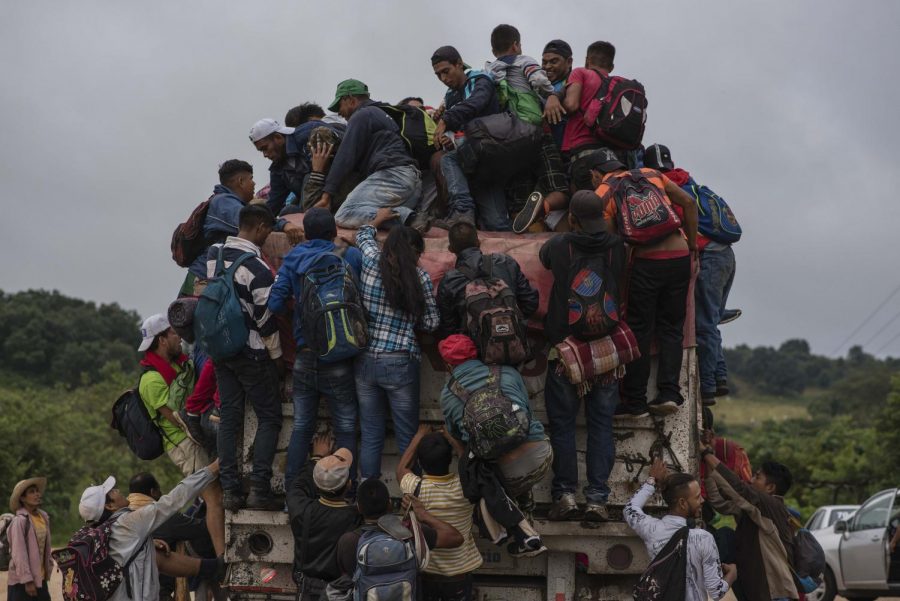Caravan Update: 15,000 troops sent to U.S. border in Texas
Angel Hernandez/DPA/Zuma Press/TNS
Migrants jump on a truck in order not to have to walk a part of their long way on Nov. 3, 2018 in Sayula, Veracruz, Mexico. Most of the migrants come from Honduras. They are currently on their way through Mexico towards the U.S. border.
On Friday, Nov. 2, roughly 15,000 members of the United States military made their way to the Mexican border in southern Texas, according to NBC news.
The troops were sent by President Donald Trump in response to a group of immigrants making their way from Central America in the form of a caravan. What started as a group of only 200 in mid-October has now grown up to 7,000, sparking a highly-public political response leading up to the midterm elections this Tuesday.
The group began in San Pedro Sula, Honduras, and has made it as far as Oaxaca, Mexico.
The mass migration has followed political unrest countries such as Honduras, Guatemala, and El Salvador, sparking groups of immigrants to flee north in search of a better life and the possibility of seeking asylum in either Mexico or the United States.
While the usual strategy of immigration for this group includes the employment of a coyote — someone that an individual pays a lump sum of money to smuggle them across borders — the caravan strategy has its own advantage.
“Going alone is risky, but a caravan is safer,” Carlos Humberto Alfaro, a 38-year-old Honduran man, told The Guardian. This is the overwhelming notion of those traveling in the caravan. While the harsh conditions, long treck, and overcrowded nature of the caravan may seem futile to the public, many immigrants believe it is their best chance.
Many of these individuals felt that they are faced with two options: stay in their home countries and risk death, or flee and risk freedom. The New York Times reported on its podcast “The Daily” that there is an overwhelming feeling of hope among the community of immigrants on the caravan. Many immigrants reported feeling as though they had “made it this far,” and were “optimistic” on the trek ahead. This mentality, however, does not line up with the political controversy the caravan has sparked across the United States.
Trump first responded to the expanding news coverage of the caravan through multiple Twitter posts.
“Hopefully Mexico will stop this onslaught at their Northern Border,” and “I must, in the strongest of terms, ask Mexico to stop this onslaught — and if unable to do so I will call up the U.S. Military and CLOSE OUR SOUTHERN BORDER!” were among the President’s tweets that gained extensive online traction.
In addition, Trump did not shy away from using the caravan as a strategy to rally supporters leading up to the midterm elections this Tuesday, Nov. 6.
“I am watching the Democrat Party led (because they want Open Borders and existing weak laws) assault on our country by Guatemala, Honduras and El Salvador, whose leaders are doing little to stop this large flow of people, INCLUDING MANY CRIMINALS, from entering Mexico to U.S,” he said on Twitter.
“Fortunately, Congress — not the President — has the power of the purse, and my colleagues and I will not stand idly by as this Administration ignores congressional intent,” responded Democratic congressman Eliot Engel from New York, and member of the House Committee on Foreign Affairs, according to CNN.
As over 15,000 troops made their way to the border, the American public and politicians remained divided on the issue and how the U.S. government should respond — by either turning away or granting asylum to many of these immigrants as they risk their lives to reach the border.
The Washington Post concluded that this deployment, in combination with the cost of National Guard forces stationed there since April of this year, could cost the government more than $200 million of the $716 billion annual defense budget by the end of 2018.












Gloria E Chevres • Dec 4, 2018 at 2:16 pm
Our nation has laws that demands all Americans to obey. How come these illegals abuse our laws and demand benefits on top of everything. Democrats are not listening to the majority of us that want to protect our borders! How can we fix unlawful Congress?
Teresa • Nov 14, 2018 at 12:23 pm
CLOSE THE BORDER!!!!!!!!!!!
Teresa • Nov 14, 2018 at 12:20 pm
SEND THEM BACK. The United States is not a third world country. Those people have no idea how to conduct themselves and follow laws. I believe nothing short of crime and dirty living is being brought here. I am a US citizen that lives in South Texas. I will never welcome them.
Octaviana • Nov 5, 2018 at 9:34 pm
I am a U S. Citizen that had a auto accident in Mexico. And guess what?? I had. NO rights in. Mexico!!! Why do this immigrants have rights here ??? I just dont understand!!!
Anthony brooks • Nov 5, 2018 at 6:55 pm
In 1970, military killed our own innocent college students for protesting war in vietnam, they won’t give their military over to protect our boarders with a shoot to kill order for invasion of our country-you gotta be shitting me- this is what America is today! This is what it’s come to! And I’m supposed to be proud? If my father, grandfather, and forefathers who gave their lives ,
knew what this america has come to today, they would have committed suicide rather then died for their country- I tell you now, the only reason I’m here is it’s better than some third world country -not by much! America has gone to hell in a hand basket!!
Karen • Nov 5, 2018 at 7:20 am
Our laws are a joke and need to be changed and we do a new wall that old wall can be kicked down by an old lady in her 90’s . US must send a message that you must do things the right way not just rushing into this country when you feel like it and how you feel like it., I will never again vote for the Dems they have become and disgrace to this country supporting such nonsense like this.
Rosalie galeotti • Nov 5, 2018 at 3:19 am
I support president trump. Closing the border to prevent the invasion. They will tell us anything to get into our country. We have enough problems without them. Millions of homeless people and citizens who need the jobs immigrants want. I think we should stop all immigration from the third world.
Bob Carter • Nov 4, 2018 at 9:54 pm
People actually want these illegals in the U.S. not
to mention being criminals?! What is wrong with us? We have a immigration dept. Why can these people not immigrate to the U.S. legally? This whole thing was I’ll conceived and illegal from the word GO. Trump is not to blame, he had a mess to straighten out from the day he took office. Now, he’s enforcing laws others won’t. It’s a shame Americans won’t see this. Those who want criminals admitted are probably criminals.